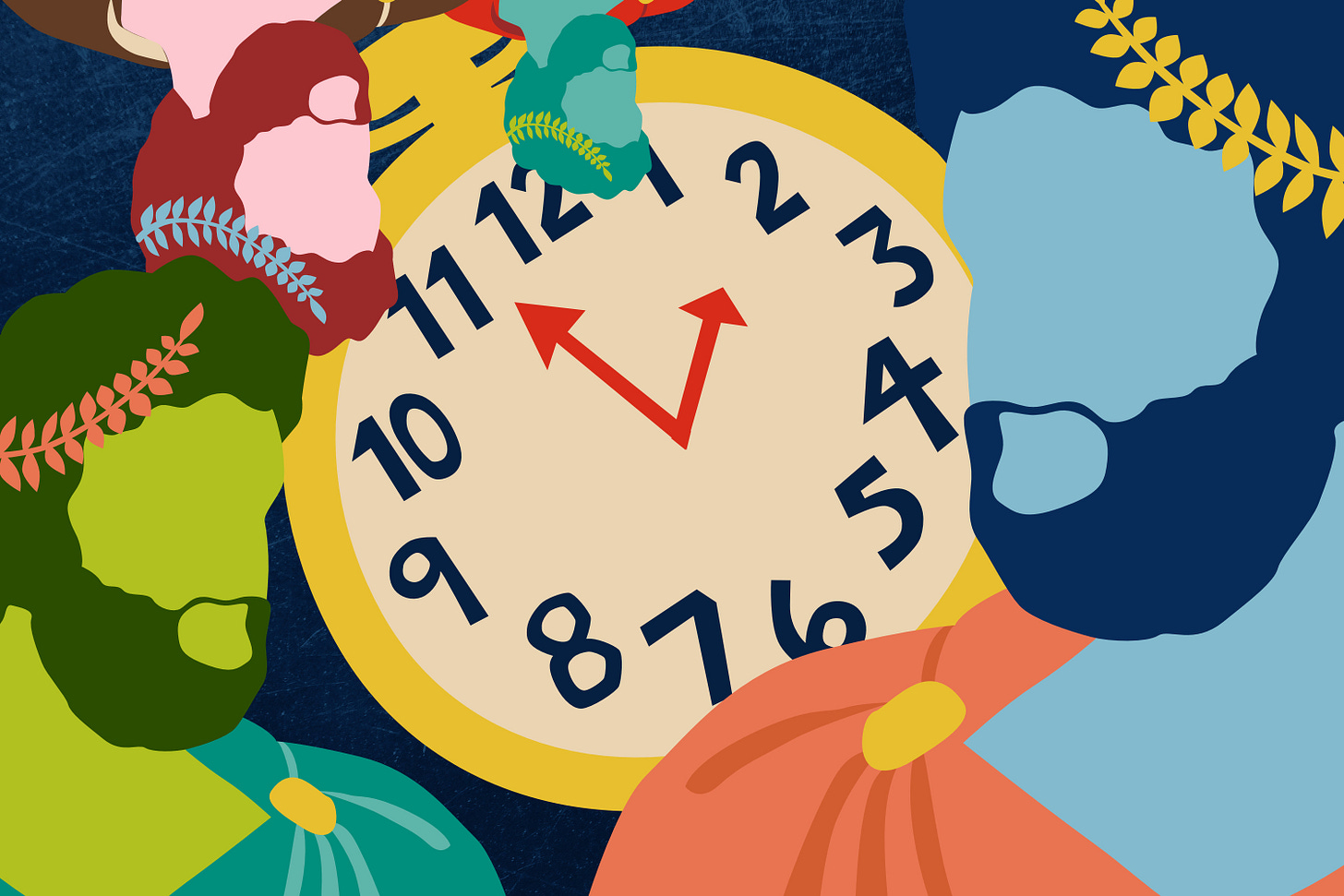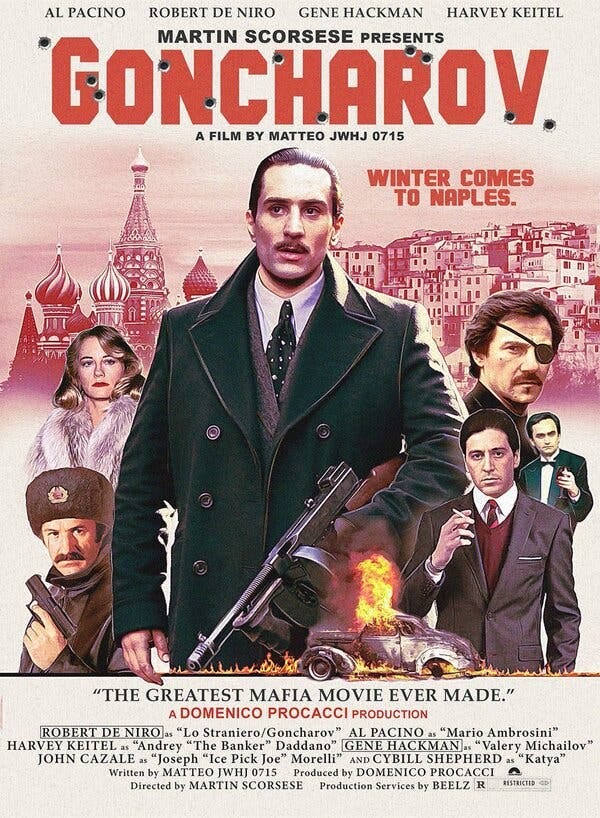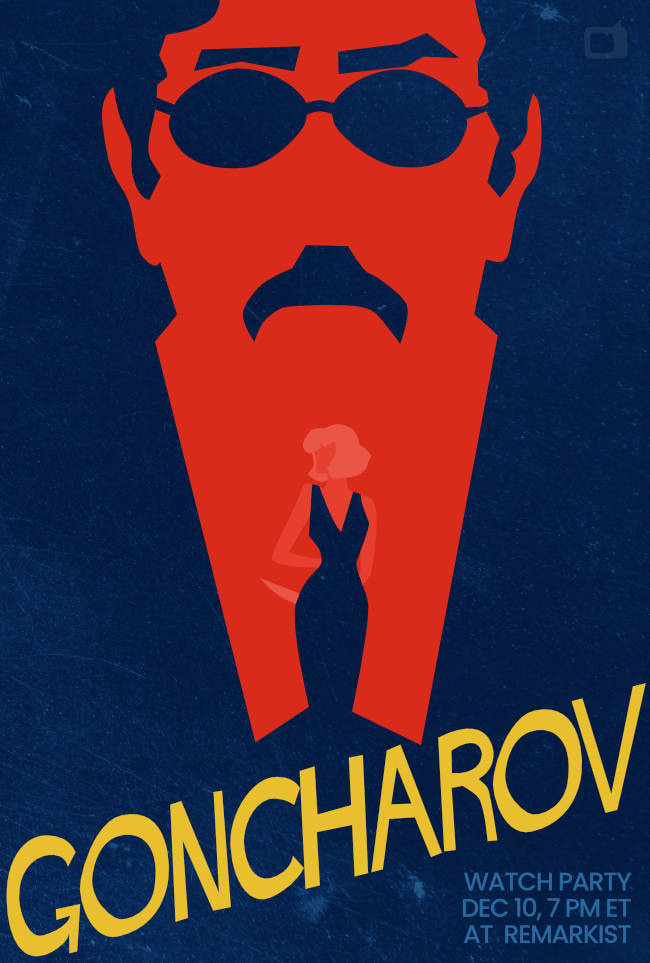‘Goncharov’: Will Future Communities Dream Up Our Shared Myths?
Studios and publishers control humanity's most powerful tool, but that might be changing.
The ancient greek poet Homer, to whom the Iliad and the Odyssey are both attributed, was probably as real as Homer Simpson. At least according to most modern academics still concerned with this question. Sure, there was likely some bard of the 8th century BC known for killer renditions at Greece’s open-mic nights. But the Homer? The man, the myth, the legend… may just be that.
The current consensus is that the Iliad and the Odyssey weren’t even first written. They were part of an earlier oral tradition of Greek mythology, which evolved into the textual versions we now study. Historian Adam Nicolson says that it’s best to think of Homer as an “it” thaen a “he.” The real author of the Iliad and the Odyssey, Nicolson says, was an entire culture–meaning the figure who countless classical scholars have lauded as the king of poets is no more than a pseudonym of ancient Greece’s storytelling heritage. And that legacy still influences Western culture thousands of years later in the form of Jedi-odysseys and Marveliads.

If you believe this take on the legendary Homer (and I’m sure you can tell, I do) the formal authorship of mythology is actually pretty recent. Mythopoeia, as J. R. R. Tolkien coined the term, describes the type of fiction he and other nerds like him pioneered–the fabricated myth we mostly find in fantasy and sci-fi. And if you think about it, there is something mythical about giving one person the title of mythmaker… which might be the point. George R. R. Martin has transcended the role of author, hasn’t he? His life has become its own legendary collection of hymns. “How does he feel about HBO canceling another GoT spin-off?” “Does he believe Aemond did it on purpose?” “What happens if George doesn’t finish the Winds of Winter?? What hero shall pick up his pen?” You can do the same for J. K. Rowling, George Lucas, James Gunn. Is the author the real mythmaker here? Or are we?
Joseph Campell believed that all myths derive from a monomyth–a proto-story that evolved into countless versions similar to how our world languages did. Each alteration was, therefore, tailored to fit that culture snugly for centuries–millennia, even. But modern cultures don’t languish in their identity for nearly as long as their classical ancestors. And in the industrialized world, it seems big cultural shifts happen every few decades. Yuval Noah Harari, in his exhilarating exploration of humanity, Sapiens, asks us to “consider a resident of Berlin, born in 1900 and living to the ripe age of one hundred. She spent her childhood in the Hohenzollern Empire of William II; her adult years in the Weimar Republic, the Nazi Third Reich and Communist East Germany; and she died a citizen of a democratic and reunified Germany.”
So this artificial form of mythmaking, popularized in the 20th century by the likes of Tolkien, Lucas, and even Hensen, may fill the same crucial role as those ancient myths did–a symbol of cultural identity and purpose, only synthesized–like Dolly the sheep–to circumvent what would otherwise take centuries of evolution to form. That way, we can easily find fresh purpose within radically shifting societies.
I’ve been wondering for the past decade, though, whether this artificial mythopoeia is meant to replace communal mythmaking. Could these modern epics–the MCU, the Wizarding World–instead be guides towards a new accelerated form of communal mythology that can now, in the information age, keep up with our fast-paced, ever-changing societies?
Another way to look at it is that these fabricated epics are, in fact, the product of hundreds of years of story evolution. They are, after all, contemporary versions of the old monomyth tropes and archetypes. Some of them, like the Arthurian Legend, were shaped by legions of authors over decades—Marvel lists 4925 creators on its site. Modern systems and institutions (capitalism, pop culture, publishers, studios, and even the greenlight 🟢 process) are simply codifying them the way religious texts became formalized law–the way the Iliad was eventually put to print.
But if that’s true, something’s gotta give. Because laymen have historically been the ones to remix their accepted myths alongside their evolving cultures. Not hired writers. Despite the safeguards put in place to prevent that remixing–whether it be the wrath of the gods or the wrath of copyright law–we no longer accept that Zeus lives in the clouds, right?
Commlore >> folklore (and faster too)
A few years ago, a Tumblr user named zootycoon posted a picture of a pair of high-top sneakers they’d received in the mail. It was obviously from a Chinese website with similar West-inspired knock-offs. The giveaway was the tongue of the sneakers, which read: Martin Scorsese Presents – Goncharov.
You can probably imagine cool kids in the east rocking these kicks like Western attire that glamorizes Asian motifs without explaining what it actually means–if it means anything. Still, this seemed to go over zoo’s head, who lamented:
“i got these knockoff boots online and instead of the brand name on the tag they have the name of an apparently nonexistent martin scorsese movie??? what the fuck”
Another user reblogged the post along with a screenshot of a comment by yet another user who playfully quipped, “this idiot hasn’t seen goncharov.” That reblog went viral. But it wasn’t until November 2022, almost two years later, that someone else on Tumblr designed a fake movie poster for the film. A photoshopped mash-up of mafia tropes and the usual suspects of 70s high-brow gangster films–DeNiro, Pacino, Keitel, Hackman. But that’s all it took. The deluge that followed that first piece of fan art was everything as epic as the poems of Homer.
In the course of a couple of weeks, Goncharov inspired 500 pieces of fan fiction on AO3 (954 as of this writing); original musical scores on YouTube. Dozens of faux critiques of the film–including one designed to look like it was written by Gene Siskel. Tumblr became a sh*tstorm of content ranging from the absurdly comical to highly realistic in practically every medium–illustration, video, sculpture, screenwriting, academic analysis, and even artificial intelligent art.
Goncharov became the ideal playground for a vast online community with a pretty aligned identity. Tumblr loves its slash fiction (LGBTQ+ character shipping). It prides itself on a nuanced understanding of modern fiction tropes. Over those weeks, a collage of micro-storytelling birthed new characters from photos of The Godfather, The French Connection, and even the 80s hit Moonlighting. Just as sci-fi fans do with their space operas, Gonchheads were committed to the realness of their Frankenstein’s monster. And we’ve heard some version of this story before. A young Russian mobster with ambition arrives in Naples to build a criminal empire before his time runs out. But his journey is vexed by the men and women who love him yet ultimately betray him. Riveting? I made up about 60% of that right now.
Browsing through the Goncharov hashtags, you feel like an archeologist excavating a mass of archaic pottery fragments, each depicting only portions of Olympian scenes. Collectively they conjure a story, one that’s hard to decipher but nevertheless compelling. You want to piece them together, but to do it, you need to fill in the gaps yourself, and so you are pulled into the mythmaking. You contribute to this massive game of telephone and become a part of the lore 🗣️🗣️🗣️ 📞.
Some celebs got involved. As pros of storytelling, they already knew the game and especially its golden rule that you do not break character even if it means you must beat some poor dead horse into the ground. Our beloved Wonder Woman, Lynda Carter, posted an old photo of herself and Henry Winkler at an event in the 70s, claiming it as a shot from the Goncharov premiere. Martin Scorsese even chimed in when his daughter sent him a text asking if he’d seen all the hubbub. He nonchalantly responded:
"Yes. I made that film years ago.”

We couldn’t help ourselves at Remarkist. We had to join in. When one of our community members, @krista, sent me a link to the Goncharov phenomenon, I knew a watch party was the way to go. It’s what we do best. So I put out a call to members interested in taking part and reached out to folks who were already playing along with the gag on our Discord. We designed a poster for the event; shared it on Tumblr. It got some love, including from Lynda’s team.
We didn’t have a movie to watch, but we had plenty to draw from. The most die-hard segment of the Goncharov fandom already had its own Discord server, with members collaborating on story outlines and film treatments. The musical score posted on YouTube was useful as background audio whenever we unmuted for some improvised commentary.
You wouldn’t have been able to hear anyone’s movie in the background, even if it was real. But according to our performers, some of us watched old VHS 📼copies recorded from TV (full of retro-Polish commercials). Some had pirated versions from BitTorrent. I signed up for a 7-day trial of an obscure streaming service (which reminds me, I forgot to cancel!)
We discussed the film’s themes as we concocted them in real-time. We commented on actions taking place as they came to us. One of our members @elle provided insights into fashion trends of the era, down to the fabrics chosen for the costumes. There was a strange dance 💃 sequence we collectively conjured up in the middle of the film that I don’t believe is in any fan treatments–although I could be wrong. Each of us did our own research before the performance. And at our improvised climax, we all managed a collective shock over what must have been the most horrific hammer-killing scene in cinema history. It wasn’t a masterpiece, but it was fun!
Why We Need This
I believe we will see more of this kind of community-built lore in the coming years and decades. We’ll probably get it from multiple communities and interwoven–just as it was in the ancient world. If this is a paradigm shift in our shared mythologies, fixed franchises like Star Wars may be supplanted by chaotic canons. Imagine something like Ready Player One, except without all the familiar brands or with mutated versions of them. Auteurs like J. K. Rowling and George R. R. Martin would make way for a myriad of modern Homers–a name, by the way, shared with the ancient Greek word for hostage. That’s apt, isn’t it–considering how copyrights make derivative fan fiction such a risk? I can’t imagine this will be the case for too much longer.
None of this should understate the importance of the singular mythmaker, though. Or those who may sift through any future chaos and compile it into something we can all agree on for a time. If the task of mythopoeia does return to communities, then I expect history will credit these individuals and institutions for helping us find our way back to collective mythmaking.
But I do think we need that return so that our stories can better reflect who we are. When 18% of Marvel fans identify as Hispanic, you would think the Marvel Cinematic Universe would match that stat with its proportion of Hispanic heroes. Yet there are none. You read that right. The MCU has a handful of Hispanic actors playing sidekicks, aliens, and non-Hispanic superheroes–but an Iron Man or Captain America who identifies as Hispanic? None. Sony’s spider-verse, not part of the MCU, recently gave us Miles Morales. But is it enough? And this isn’t just a superhero discrepancy. The whole landscape of storytelling in TV and film seems built for a different cultural identity than the many who consume it, share it, and take residency there. Think about that. Collective mythopoeia, like the kind Tumblr shaped around its own identity in a matter of weeks, can help solve this.
Remarkist’s contribution to the Goncharov lore speaks to what we’re building here: new storytelling tools for fandoms. We’re watching shows 📺 and movies 🎥 together, reading books 📚 and dissecting them, playing games 🎲 inspired by them, and engaging in all sorts of creativity around them. Fans have always been our up-and-coming storytellers, and with online communities, that seems especially true. It’s inevitable that Remarkist members begin laying the foundation for brand-new story landscapes based on the ancient structures, conventions, and archetypes we’re celebrating. We welcome fans with the voice and passion for singing those epics with us.
If this Goncharov stuff sounds interesting, here are two more cool perspectives from writers on Substack. Please give them some ❤️:
They’re both great reads, and I recommend them.










